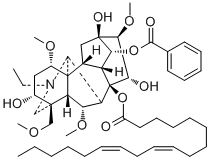LipoaconitineCAS# 81941-14-2 |

Quality Control & MSDS
Package In Stock
Number of papers citing our products

| Cas No. | 81941-14-2 | SDF | Download SDF |
| PubChem ID | N/A | Appearance | Oil |
| Formula | C50H75NO11 | M.Wt | 866.1 |
| Type of Compound | Alkaloids | Storage | Desiccate at -20°C |
| Solubility | Soluble in Chloroform,Dichloromethane,Ethyl Acetate,DMSO,Acetone,etc. | ||
| General tips | For obtaining a higher solubility , please warm the tube at 37 ℃ and shake it in the ultrasonic bath for a while.Stock solution can be stored below -20℃ for several months. We recommend that you prepare and use the solution on the same day. However, if the test schedule requires, the stock solutions can be prepared in advance, and the stock solution must be sealed and stored below -20℃. In general, the stock solution can be kept for several months. Before use, we recommend that you leave the vial at room temperature for at least an hour before opening it. |
||
| About Packaging | 1. The packaging of the product may be reversed during transportation, cause the high purity compounds to adhere to the neck or cap of the vial.Take the vail out of its packaging and shake gently until the compounds fall to the bottom of the vial. 2. For liquid products, please centrifuge at 500xg to gather the liquid to the bottom of the vial. 3. Try to avoid loss or contamination during the experiment. |
||
| Shipping Condition | Packaging according to customer requirements(5mg, 10mg, 20mg and more). Ship via FedEx, DHL, UPS, EMS or other couriers with RT, or blue ice upon request. | ||

Lipoaconitine Dilution Calculator

Lipoaconitine Molarity Calculator
| 1 mg | 5 mg | 10 mg | 20 mg | 25 mg | |
| 1 mM | 1.1546 mL | 5.773 mL | 11.546 mL | 23.092 mL | 28.865 mL |
| 5 mM | 0.2309 mL | 1.1546 mL | 2.3092 mL | 4.6184 mL | 5.773 mL |
| 10 mM | 0.1155 mL | 0.5773 mL | 1.1546 mL | 2.3092 mL | 2.8865 mL |
| 50 mM | 0.0231 mL | 0.1155 mL | 0.2309 mL | 0.4618 mL | 0.5773 mL |
| 100 mM | 0.0115 mL | 0.0577 mL | 0.1155 mL | 0.2309 mL | 0.2887 mL |
| * Note: If you are in the process of experiment, it's necessary to make the dilution ratios of the samples. The dilution data above is only for reference. Normally, it's can get a better solubility within lower of Concentrations. | |||||

Calcutta University

University of Minnesota

University of Maryland School of Medicine

University of Illinois at Chicago

The Ohio State University

University of Zurich

Harvard University

Colorado State University

Auburn University

Yale University

Worcester Polytechnic Institute

Washington State University

Stanford University

University of Leipzig

Universidade da Beira Interior

The Institute of Cancer Research

Heidelberg University

University of Amsterdam

University of Auckland

TsingHua University

The University of Michigan

Miami University

DRURY University

Jilin University

Fudan University

Wuhan University

Sun Yat-sen University

Universite de Paris

Deemed University

Auckland University

The University of Tokyo

Korea University
- Lipodeoxyaconitine
Catalog No.:BCN9425
CAS No.:244190-83-8
- Minisecolide D
Catalog No.:BCN9424
CAS No.:1967030-78-9
- 3-(Hydroxyacetyl)indole
Catalog No.:BCN9423
CAS No.:2400-51-3
- 4-Hydroxyxanthone
Catalog No.:BCN9422
CAS No.:14686-63-6
- Macluraxanthone
Catalog No.:BCN9421
CAS No.:5848-14-6
- Deoxymikanolide
Catalog No.:BCN9420
CAS No.:23753-57-3
- 4,5-Dihydropiperlonguminine
Catalog No.:BCN9419
CAS No.:23512-53-0
- Dihydromikanolide
Catalog No.:BCN9418
CAS No.:23758-04-5
- 2,6-Dihydroxyxanthone
Catalog No.:BCN9417
CAS No.:838-11-9
- Minisecolide C
Catalog No.:BCN9416
CAS No.:1967030-77-8
- Withaphysalin A
Catalog No.:BCN9415
CAS No.:57423-72-0
- Withaphysalin E
Catalog No.:BCN9414
CAS No.:118985-24-3
- 3-epi-Dihydroscandenolide
Catalog No.:BCN9427
CAS No.:1137951-08-6
- cis-Shegansu B
Catalog No.:BCN9428
CAS No.:865474-99-3
- Methyl 2,4,6-trihydroxybenzoate
Catalog No.:BCN9429
CAS No.:3147-39-5
- Elatoside E
Catalog No.:BCN9430
CAS No.:156980-30-2
- 1H-Indole-3-carbaldehyde
Catalog No.:BCN9431
CAS No.:487-89-8
- Scandenolide
Catalog No.:BCN9432
CAS No.:23758-16-9
- Neoorthosiphol A
Catalog No.:BCN9433
CAS No.:243448-72-8
- Orthosiphol B
Catalog No.:BCN9434
CAS No.:144078-08-0
- Physaminimin N
Catalog No.:BCN9435
CAS No.:2131235-87-3
- [4]-Gingerdiol
Catalog No.:BCN9436
CAS No.:53254-75-4
- Cucurbitacin IIa 2-O-glucoside
Catalog No.:BCN9437
CAS No.:77704-34-8
- 1,5-Epoxy-3-hydroxy-1-(3,4-dihydroxy-5-methoxyphenyl)-7-(4-hydroxy-3-methoxyphenyl)heptane
Catalog No.:BCN9438
CAS No.:182227-93-6
Four new diterpenoid alkaloids from Aconitum japonicum subsp. subcuneatum.[Pubmed:29052027]
J Nat Med. 2018 Jan;72(1):230-237.
Diterpenoid alkaloids with remarkable chemical properties and biological activities are frequently found in plants of the genera Aconitum, Delphinium, and Garrya. Accordingly, several diterpenoid alkaloid constituents of Aconitum and Delphinium plants as well as their derivatives exhibited cytotoxic activity against lung, prostate, nasopharyngeal, and vincristine-resistant nasopharyngeal cancer cell lines. Four new C19-diterpenoid alkaloids, 14-anisoyllasianine (1), 14-anisoyl-N-deethylaconine (2), N-deethylaljesaconitine A (3), and N-deethylnevadensine (4), together with 17 known C19- and C20-diterpenoid alkaloids, were isolated in a phytochemical investigation of rhizoma of Aconitum japonicum THUNB. subsp. subcuneatum (NAKAI) KADOTA. Their structures were elucidated by extensive spectroscopic methods including NMR (1D and 2D), IR, and MS (HRMS). Eight known diterpenoid alkaloids, Lipoaconitine, lipomesaconitine, aconine, nevadenine, talatisamine, nevadensine, ryosenamine, and dehydrolucidusculine, were isolated the first time from A. japonicum subsp. subcuneatum. Three of the new C19-diterpenoid alkaloids (1, 3, 4) and six of the known diterpenoid alkaloids were evaluated for cytotoxic activity against five human tumor cell lines.
Hypaconitine, the dominant constituent responsible for the neuromuscular blocking action of the Japanese-sino medicine "bushi" (aconite root).[Pubmed:3210453]
Jpn J Pharmacol. 1988 Oct;48(2):290-3.
The neuromuscular blocking actions of several constituents extracted from Japanese-sino medicine, aconite, were compared in mouse phrenic nerve-diaphragm muscle preparations. Hypaconitine (HAT) was more potent than aconitine (ATN), mesaconitine (MAT) and deoxyaconitine. Lipohypaconitine, coryneine and lipodeoxyaconitine were less effective. Lipoaconitine, benzoylmesaconine, higenamine, kobusine and chasmanine were not effective. The blockades by HAT, ATN and MAT were not recovered by neostigmine. The mechanisms of blockade were similar to that of aconite crude extract. These results suggest that aconite action is dependent on HAT, a main constituent.


